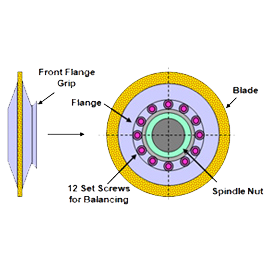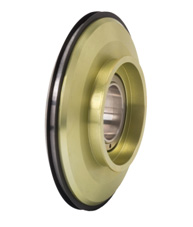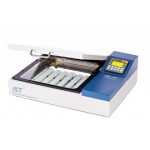Flanges
2-3″ Flange
4″ Flange
Dynamic Balancing of Flange Set

By Gideon Levinson, Senior Dicing Blades R&D Specialist
General
Any round object that rotates at any given speed per minute causes some vibrations due to asymmetric mass distribution. At higher speeds, the vibration phenomenon is accelerated.
The vibration issue is very critical in a dicing system, as parts are rotating at relatively high speeds.
The main reason for vibrations on a dicing system is multiple parts assembled together on the spindle, such as:
• The spindle itself
• The wheel mount
• Flange assembly with blade.
Although the spindle and wheel mount are balanced, the flange & blade assembly are the main reason for more vibrations. In most applications, the existing vibrations of the flange & blade assembly can be tolerated without any balancing requirements. However, some delicate applications require an extra dynamical balancing to achieve better-cut quality. Following are some applications requiring perfect balancing to achieve better cut quality requirements:
• Ultrasound sensors dicing PZT for the medical industry
• Magnetic heads for the storage industry.
Principle of Dynamic Balancing on Dicing Saws
Balancing a flange/blade assembly needs to be performed on the saw. A balanced flange out of the saw may help but is not a perfect solution as the flange and the blade can be mounted in different orientations and will result in different unbalanced characteristics. Balancing the flange set on the saw is actually called dynamic balancing. This is a well-known process and a common practice for balancing, for example, car wheels.
4″ Flange Handling – Step By Step

Options
ADT offers special features for our flanges to support your process needs.
Multi Blades Flange set
 For specific high throughput type applications, ADT can offer multi-blade flange sets. The flange design in this case has a wider step to accommodate more than one single blade and a single or more spacers. The accuracy of the spacers is critical to meet the indexing accuracy required per customer application.
For specific high throughput type applications, ADT can offer multi-blade flange sets. The flange design in this case has a wider step to accommodate more than one single blade and a single or more spacers. The accuracy of the spacers is critical to meet the indexing accuracy required per customer application.
Specific blade and flange handling tools are required in some cases to make the blade and spacer mounting easier and safer.
Attention should be given to the balancing as a multi-flange set has more mass and is more sensitive to vibrations.
To meet the right indexing between blade replacements, flange clamping torque is critical.  For specific inquiries, the ADT engineering team is always available to provide technical assistance for a specific application.
For specific inquiries, the ADT engineering team is always available to provide technical assistance for a specific application.


